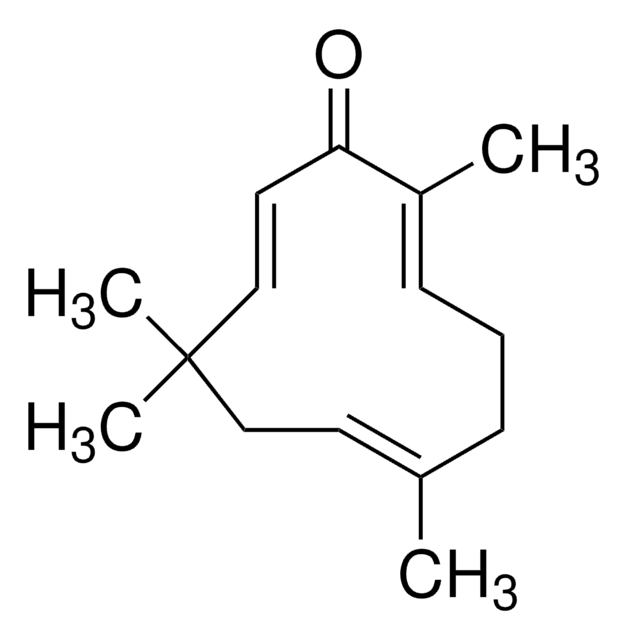Z3902
Zerumbone
≥98% (HPLC)
Synonym(s):
(2E,6E,10E)-2,6,9,9-tetramethylcycloundeca-2,6,10-trien-1-one, Zerumbone (6CI,7CI)
About This Item
Recommended Products
assay
≥98% (HPLC)
form
powder
color
white to off-white
solubility
DMSO: ≥10 mg/mL
storage temp.
2-8°C
SMILES string
C\C1=C/CC(C)(C)\C=C\C(=O)\C(C)=C\CC1
InChI
1S/C15H22O/c1-12-6-5-7-13(2)14(16)9-11-15(3,4)10-8-12/h7-9,11H,5-6,10H2,1-4H3/b11-9+,12-8+,13-7+
InChI key
GIHNTRQPEMKFKO-SKTNYSRSSA-N
Looking for similar products? Visit Product Comparison Guide
General description
Application
- for liquid chromatography with mass spectrometry (LC-MS-MS)
- to investigate its potential application in the prevention
- treatment of esophageal squamous cell carcinomas (ESCC)
Biochem/physiol Actions
signalword
Warning
hcodes
Hazard Classifications
Aquatic Acute 1 - Skin Sens. 1
Storage Class
11 - Combustible Solids
wgk_germany
WGK 3
flash_point_f
Not applicable
flash_point_c
Not applicable
Certificates of Analysis (COA)
Search for Certificates of Analysis (COA) by entering the products Lot/Batch Number. Lot and Batch Numbers can be found on a product’s label following the words ‘Lot’ or ‘Batch’.
Already Own This Product?
Find documentation for the products that you have recently purchased in the Document Library.
Customers Also Viewed
Articles
Cell cycle phases (G1, S, G2, M) regulate cell growth, DNA replication, and division in proliferating cells.
Our team of scientists has experience in all areas of research including Life Science, Material Science, Chemical Synthesis, Chromatography, Analytical and many others.
Contact Technical Service


![[6]-Gingerol ≥98% (HPLC)](/deepweb/assets/sigmaaldrich/product/structures/259/444/6877889c-1cc0-47f5-b807-f847deadec1d/640/6877889c-1cc0-47f5-b807-f847deadec1d.png)








